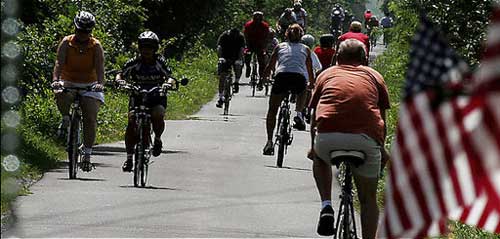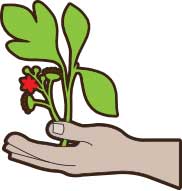What can we do to help?
Disclaimer: This material is being kept online for historical purposes. Though accurate at the time of publication, it is no longer being updated. The page may contain broken links or outdated information, and parts may not function in current web browsers.
What can we do to help?

Can I help nature to help us?
Yes! We can all take notice of our environment. We can learn how our planet works. We can learn how to live on it without making a mess of it. We can help to keep it magnificent for ourselves, our children and grandchildren, and other living things besides us.
Some of the ways you can help may have to wait until you are a little older—like choosing an energy-efficient car, installing solar panels on the roof of your house, or choosing a "green career."
But there are many important ways you can help right now.
You can help by growing your own vegetables and fruits. You can help by planting a tree. Your new plants and trees will help to remove the greenhouse gas CO2 from the air. If you grow some of your own food, you will also help to prevent more CO2 from entering the air from the fossil-fuel-burning trucks, planes, and ships that transport your food to you from far away.

First Lady Michelle Obama gets lots of help planting a vegetable garden. Trees are easy to plant too. We should all plant lots of vegetables and trees!
How can I reduce my "carbon footprint"?

Your carbon footprint is the amount of carbon dioxide released into the air because of your own energy needs. You need transportation, electricity, food, clothing, and other goods. Your choices can make a difference.
Swap old incandescent light bulbs for the new compact fluorescent lights (CFLs). They use only 25% as much electricity to give the same light. They last ten times longer.
Turn off lights, TVs, computers, when you do not need them.
Unplug! Any electronic gadget you can turn on with a remote (TV, DVD player, Nintendo, Xbox) uses power even when it is "off." Appliances with a digital clock (like a coffee maker) or a power adapter (like a laptop computer) also suck power like a sneaky vampire. Plug these kinds of things into a surge protector or power strip that has an on/off switch. Then you can shut off all the power without unplugging each gadget.
There are even power strips that glow to show you how much power is going through them, and power strips you can control from your computer or iPhone.
Turn up the thermostat on the air conditioning when it's hot. Use fans if you're still hot. They use much less power.
Turn down the thermostat on the heating when it's cold. Sweaters, blankets, and socks are good for you and better for the planet.
Walk or ride your bike instead of taking a car everywhere. Even a 2-mile car trip puts 2 pounds of CO2 into the atmosphere!
If you must ride, carpool.
Stay out of the drive thru! When you go to a fast-food place, ask your driver to park the car and let you walk inside, rather than sitting in a line of cars with the engine running and polluting.

Bikes are a great form of green transportation. Sometimes, in the big city with lots of traffic, they are even faster than cars! Credit: USDOT.
How can I reduce my trash pile?
Ask your parents to buy reusable grocery bags. Help them to remember to get them out of the car and take them into the store.

Recycle everything you can. If your city does not pick up recycled materials, find out who you can talk to about starting this service. You should be recycling paper, aluminum cans, cardboard, food cans, plastic, glass, newspapers, magazines, junk mail, phone books, and anything else made of paper.
Shop thrift stores. "BYOM." Bring your own mug. That's what you can tell your parents when they stop to buy their morning coffee. Use less paper whenever possible. Save the trees.
Drink tap water—filtered, if you like—instead of bottled water. Carry your drinking water in a reusable bottle. Plastic water bottles are an environmental disaster!
Use fewer containers. Buy the product that uses less packaging material. Even if you recycle packaging materials, it takes energy to create them in the first place and energy to remake them into something else.
Practice by playing "Recycle This!."
Do I need to save water too?
People and animals in many parts of the world do not have clean, safe water to drink. As many more regions are hit by drought, this problem will become even more serious. The sooner we start conserving water, the better off we all will be. Be aware of how much water you use.
Imagine you live in a recreational vehicle (RV), and your water tank holds only 50 gallons. Every time you turn on the water, the noisy electric water pump has to turn on too, sucking up your RV's battery power. Would you keep the water running while you brush your teeth? Would you spend 15 minutes in the shower using up all the water in the tank and depleting the battery? Would you plant a thirsty lawn in front of your RV if you were parked in the desert? Of course not!
How can I make a real difference?
You can choose a "green career." You can help to solve climate change problems and challenges. These are the exciting careers of the future. They range from designing satellites for NASA to fixing wind-energy generators to planning drought-tolerant landscapes for homes and parks. Many of the possible careers haven't even been thought of yet. You could invent your own career! Check out some Green Careers.













